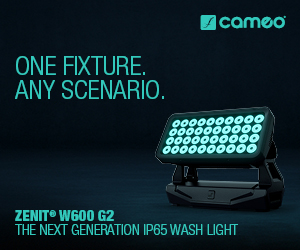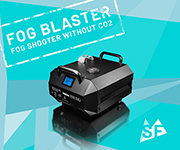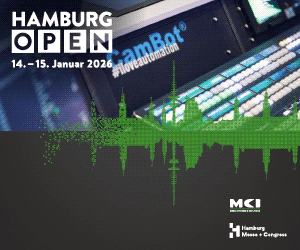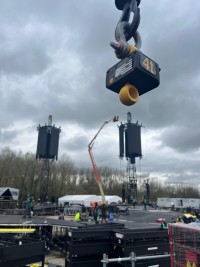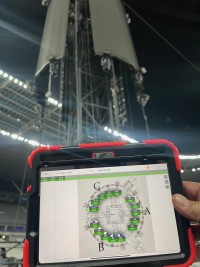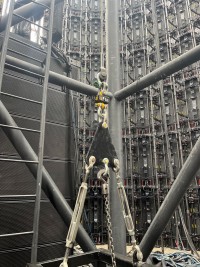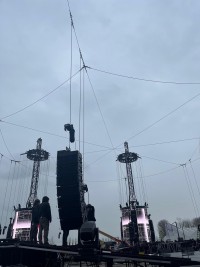Aktuelle News & Schlagzeilen
Eilon Engineering and KDH Precision team up for enhanced production safety on Metallica “M72” world tour
KDH Precision, founded and led by rigging specialist Chad Koehler, highlights the role of load cells in monitoring load distribution and ensuring safety in the entertainment industry. Since 2017, the company has provided rigging services for Metallica and collaborated with numerous major events and A-list acts, including Rihanna, Beyoncé, The Rolling Stones, Shania Twain, Carrie Underwood, Kid Rock, and most recently, Chris Stapleton and Zach Bryan.
“With the ever-growing complexity of production spaces, ensuring the safety of fans, staff, and talent has become an escalating concern”, says Koehler, who has relied on Eilon Engineering load cells to monitor loads for the past fifteen years. “The use of advanced technology, coupled with the increasing size, weight, and dynamics of shows, as well as the rise in outdoor performances, has exposed the often-overlooked dangers of overload.”
When working with a show design, KDH collaborates with staging and production companies to determine the most effective monitoring system required for safe load handling. Koehler says the number of load cells necessary varies depending on the design. “For the current Metallica tour, we worked with StageCo and Tait to determine the number of pick-up points and load dispersal”, he reports. “Once we knew how many screens we had, we then put the load cell system together.” To cover the Metallica “M72” world tour, KDH Precision acquired 130 units, including 120 active load cells and ten spares.
As Metallica’s head rigger for the past eight years, Koehler and KDH Precision has played a key role in numerous high-profile shows, including the band’s 2017 “WorldWired” tour - a massive 100+-ton production featuring kinetic LED cubes, with safety ensured by forty load cells. KDH also contributed to the “S&M2” performances and the band’s 40th anniversary shows.
KDH initially employed Eilon load cells in 2008 to monitor a large locomotive train set piece that became an iconic visual during AC/DC’s two-year “Black Ice” world tour, and has used Eilon load cells on a previous Metallica tour as well. Given that “M72” is an extensive outdoor production, it presents several challenges. The setup involves eight towers comprised of 30-ft tall circular LED screens, which are essential components of the design. To monitor the screen loads from setup to tear down, KDH uses Eilon’s Ron StageMaster 4-ton G4 wireless load cells.
Each tower features three screens, and each screen has five motor points, resulting in a total of 120 points that can be monitored. “When you have a significant number of hoists positioned closely together, maintaining perfect levelness to the ground becomes challenging”, says Koehler. “Even a slight deviation of half an inch can affect the applied load on the structure above. When we have five hoists supporting one-third of a screen, and a total of fifteen hoists collectively, a difference of half an inch to an inch can lead to significant swings in weight distribution. You can’t tell by just looking at it. We need to precisely know the load, and the way to achieve that is through our Eilon system.”
While the different forces on a load must be managed in any setting, the importance of monitoring is particularly magnified in outdoor shows, where adverse weather conditions, especially wind, can destabilize the rig. “In a controlled arena setting, my focus is more about adapting the show so it looks exactly like it did in the previous city”, Koehler explains. “It involves dealing with scoreboards and staying within the structural tolerances. However, in an outdoor show, where all the gear is exposed, the working environment becomes more challenging. The wind can be the real enemy when we’re trying to get all the elements in place and then down again.”
While raising and lowering the screens on the “M72” tour, precautions are taken to ensure stability, but the wind remains a formidable challenge, as Koehler elaborates: “The wind exerts additional force and load on the structure, and the screens can act like sails. Every element has tolerances, and load cells allow us to stay within those limits when dealing with such big moving objects. Particularly in high winds, load monitoring becomes absolutely crucial. When hit by strong winds, the weight of the screens can escalate from 5500 lbs to as much as 7200 lbs. Consequently, adjusting the weight during the lifting process becomes extremely critical and monitoring that wouldn’t be possible without load cells.” He says they were fortunate on the European leg of the tour with little wind and rain but mentions encountering rain and exceptionally high winds in Belgium at the StageCo grounds, just before the tour commenced.
Koehler adds that he has found that a curved screen acts differently than a straight screen, providing another reason for weight monitoring: “The screens used on ‘M72’ are curved, and a curved screen tends to roll until you get them fully built. So having the load cells, making sure the load is equal and where it’s supposed to be, is essential.”
To monitor the 120 load cells, KDH Precision employs a portable Ron StageMaster PRR receiver in conjunction with an iPad. The wireless system allows him to view load maps while moving around the stadium. The load cells transmit data via radio frequency to the PRR (Portable Radio Receiver), which serves as a handheld, Bluetooth-compatible load monitoring system. Riggers can download the app to a tablet or smartphone. “The ability to move around freely is priceless, and I don’t have to worry about any cables or other complications”, Koehler notes.
If the load approaches the overload or underload limit, the system triggers an alert, prompting immediate adjustments to ensure safety. Additionally, a close eye is kept on weather forecasts and wind conditions using anemometers installed atop the structure. “I have complete confidence in the calibration, up-to-date status, and reliability of the equipment I have”, Koehler affirms. “The load cells not only allow us to perform our job safely but it’s a win-win for everyone involved. Eilon’s load cells have been instrumental in helping set up systems for each tour.”
The consequences of unpredictable load distribution can be severe and Koehler emphasizes that any show involving suspended loads above people should be executed with comprehensive knowledge of the forces involved. Despite this, load cells have not been universally adopted, even in large-scale productions. It’s a tool he hopes will be a requirement in the future.
“The technology is there but it’s often not being utilized, leading to incidents where people are unaware of the loads they are applying”, he concludes. “As shows continue to grow in size and weight, and as people become increasingly concerned about liability and safety, I believe load cells will see more widespread use. We need to embrace the tools available to us. It’s a matter of responsibility.”
(Photos: Eilon Engineering/KDH Precision)
SCHLAGZEILEN
news archiv
suche
© 1999 - 2025 Entertainment Technology Press Limited News Stories

